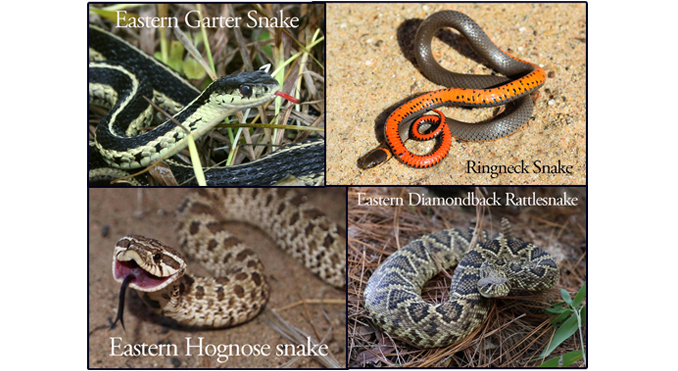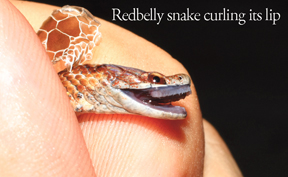
Snakes of the East End

Happy summer everyone. I hope this month’s column finds everyone healthy and less stressed than the past couple months. This month I’m going to talk about one of my all-time favorite species, snakes. When I was a kid, and everyone was hoping to be astronauts and firemen, I wanted to be a herpetologist. I loved snakes and all that there was to learn about them. This early passion was not shared with my family, specially my sister who unfortunately came literally nose to nose with one or two of my slithering friends during those years. I never did become a herpetologist, but I followed my dream and found myself in a similar yet larger spectrum of animal study; all of wildlife.
New York is home to 17 snake species, three of which are poisonous but not found on Long Island. On the island, 13 snakes call our home, their home. The most common are the Garter Snake which some folks mistakenly call a Garden snake, mostly because they are often seen resting in garden beds waiting for a passing-by meal of crickets, toads or mice. The Garter snake is actually named after the clothing accessory worn by men to keep their socks held up (and woman’s stockings of course). It’s the snakes stripes that resembles the garter. Both the Common and Eastern Garter snakes are found here locally. Separated by a slight back pattern difference. Another very common snake on Long Island is the Northern Water snake. These are a more aggressive snake found very close to the shorelines of inland water bodies. I say more aggressive, referring to how they respond when they are surprised by a human or grabbed. They simply tend to bite a lot and although they are not venomous, their bite still stings a bit. Their saliva also prevents clotting, so their bit often results in a small wound with lots of hard to stop bleeding.
The beautiful Eastern Milk snake is another common snake in our area. Their appealing body pattern is one of my favorites among the 24 subspecies of Milk snakes around the world. We also have the infamous Black Rat snake and the Northern Black Racer. The Black rat snake eats up to 100 rodents a year which makes them a very beneficial snake to our ecology. A similar looking snake with an added white patch under the throat and chin area, the Black Racer, is the largest and fastest snake on Long Island, reaching an average length of 55″ (maximum of 70″). These snakes live up to 10 years and although they are non-venomous, their bite can be quite painful. They will only bite to defend themselves.
 Some of the more secretive snakes in our area that are rarely seen are the Smooth Green snake which hibernate together in large numbers. They are a beautiful bright green with a white underbelly. The Worm snake is hardly ever seen in the open. They grow to a common length of 7.5″ inches, but some have reached an amazing length of close to 11″. These are often confused with large earthworms. Northern Ringneck snakes are small grey to black snakes with a thin orange band around their necks. Simple when viewed from above, but when threatened, they curl up a large portion of their rear body and tail to expose a bright and beautiful yellow to orange to red belly. This makes them look larger and more intimidating to potential predators. The Redbelly snake looks similar to a dark Garter snake, but with a bright red belly from neck to tail tip. The Redbelly is rarely seen anymore. I’ve seen one in my life here on the east end. When threatened, they do not curl up their tail like a Ringneck, instead they curl their upper lip.
Some of the more secretive snakes in our area that are rarely seen are the Smooth Green snake which hibernate together in large numbers. They are a beautiful bright green with a white underbelly. The Worm snake is hardly ever seen in the open. They grow to a common length of 7.5″ inches, but some have reached an amazing length of close to 11″. These are often confused with large earthworms. Northern Ringneck snakes are small grey to black snakes with a thin orange band around their necks. Simple when viewed from above, but when threatened, they curl up a large portion of their rear body and tail to expose a bright and beautiful yellow to orange to red belly. This makes them look larger and more intimidating to potential predators. The Redbelly snake looks similar to a dark Garter snake, but with a bright red belly from neck to tail tip. The Redbelly is rarely seen anymore. I’ve seen one in my life here on the east end. When threatened, they do not curl up their tail like a Ringneck, instead they curl their upper lip.
Northern Brown snakes and Eastern Ribbon snakes are also common snakes throughout the island and state, but my all-time favorite has always been and still is, the Eastern Hognose snake. Not only my favorite snake, but one of my favorite species of animal. The Hognose has many interesting characteristics, but there is one special behavior that makes the hognose unique from all other colubrids, and that lies in THEIR defensive methods. We’ll talk about that shortly.
The hognose gets its name from its upturned nose that is useful when digging a burrow or searching for buried eggs in loose dirt or sand. Although hognose snakes can be found in a variety of habitats including the woods, they are more often found in the dunes on the east end of Long Island where they enjoy the abundance of food. Toads mostly, but also shorebird eggs like those of Plovers and Terns.
Although I assured you that there are no venomous snakes on Long Island, I was referring to venomous to humans. A Hognose snake IS actually venomous, but because of the circumstances they are considered non-venomous to humans, therefore a non-venomous species of snake. In fact, the Hognose is mildly venomous but only toxic to small prey like frogs, toads and rodents. They also have fangs, but not like those of a Rattlesnake. A Hognose is rear-fanged and venom is not injected like a viper, but rather the venom is excreted from the gum-line and flows down their grooved fang and into the prey the bite was intended for.
Should the Hognose find itself on the opposite end of the food scenario, forcing it to defend itself, well this is where the Hognose really shines above all other snakes. Should a Hognose become threatened, it immediately relies on three strategies of defensive and evasion. The first is to pretend it’s a much more dangerous snake, the rattlesnake. The Hognose curls up like a rattler and rapidly shakes its buttonless tail. Its body pattern slightly resembles that of a rattlesnake so this first line of defense usually works quite well. The problem is, without buttons on the tail, it does not make the tell-tale warning sound of the rattler. The Hognose solves that problem by making the exact sound from its mouth. The hiss of a Hognose is eerily close to a rattlesnakes warning, and equally effective in most cases. However, should the rattlesnake trick not work, the Hognose steps it up and does a much more dangerous snake impersonation; the Cobra. By raising its head and flattening its neck while still hissing loudly, the Hognose mimics the Cobra in hopes of scaring away the threat. Even to a human, the Hognose will rarely bite, however it will feign strikes.
BUT THAT’S NOT ALL!! Should the mock-Cobra’s presence still not persuade the predator to move along, the Hognose has one more line of defense that almost always works. It plays dead! That’s right, it rolls on its back, opens its mouth, lets its tongue hang out and over the side, it emits a most foul and unpleasant odor and maybe even the contents of its intestines. Should one be brave enough to approach closer and handle the snake, it will remain in this thanitosis state much like an Opossum. In fact, if you right the snake on its belly, it’ll slowly curl and twist back onto its back in its pretend death pose until the threat has passed. And how does it know when the threat has passed? Its eyes remain open the entire time, and although they resemble a lifeless stare, they are very much in use, waiting for the threat to leave. Wildlife is just SO AWESOME!!!
Just north of the city and points north you’ll find the venomous Timber rattlesnake, Eastern Massasauga and the Copperhead. I actually raised a blind Eastern Diamondback rattlesnake for many years during the early 90’s. It grew to 6′ and lived a full life. I eventually donated it to a herpetologist who worked for the Discovery Network and they made my old friend a TV star, until it died from natural causes.
Snakes are a very misunderstood creature and although they strike some folks with fear and phobia, many others like myself, find them most beautiful and extremely interesting. For those who fear the snake, please understand they are here to help maintain a healthy ecology by keeping both insect and rodent populations down. That’s the skinny on snakes folks. Enjoy the summer, stay healthy and safe, and remember… Wildlife Matters!
~ Dell Cullum
Hampton Wildlife: 631-377-6555
Wildlife Rescue of East Hampton: www.WROEH.org (844) SAV-WILD

